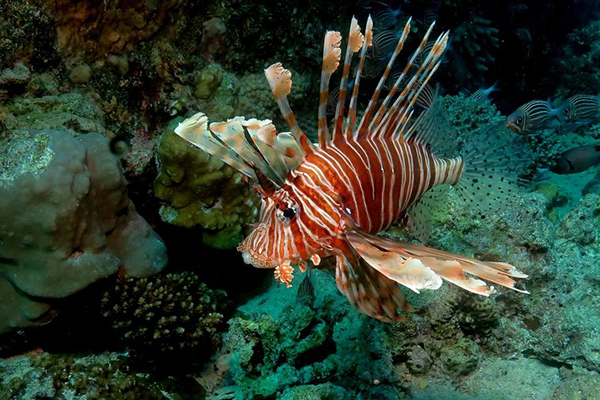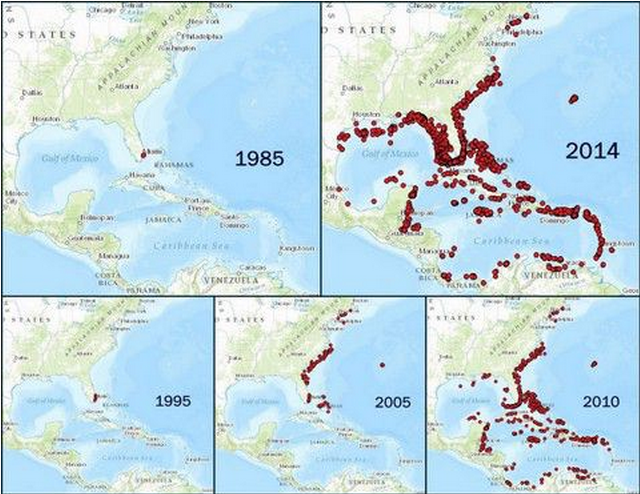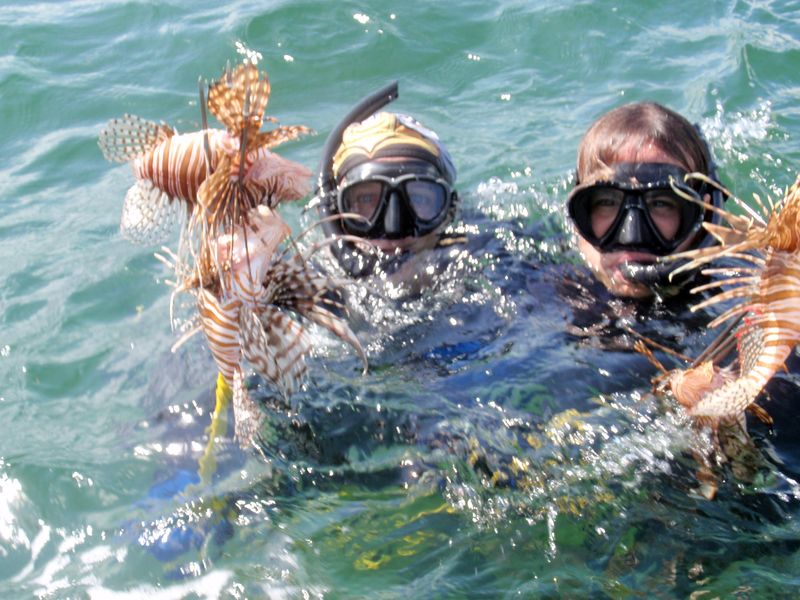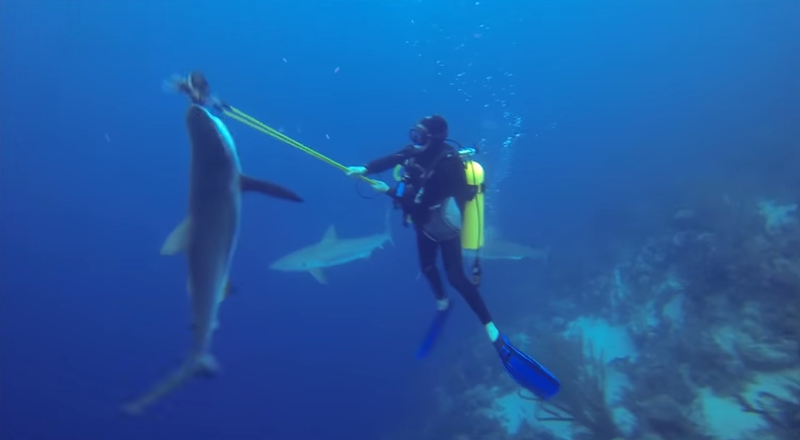
Back in 1985, a lone lionfish was first spotted off the Florida coast, possibly dumped into the ocean by a dissatisfied aquarium owner. At the time, it seemed harmless enough: a bright, colorful fish native to Indonesia that had somehow made its way over here.
No one could have imagined the disaster that would follow.
Thirty years later, the venomous lionfish has conquered the Atlantic, the Caribbean, and the Gulf of Mexico wreaking havoc on ecosystems up and down the coast. Unlike in its native Pacific habitats, there are few natural predators here to keep this invasive species in check. So the lionfish has expanded voraciously, gobbling up other reef fish and mollusks and attacking commercially important species like grouper and snapper.
By 2014, lionfish were everywhere, from North Carolina and even Rhode Island down to the coasts of Panama and Venezuela:
Lionfish sightings, 1985-2014

Above: Lionfish sightings, 1985-2014. (US Geological Survey/Florida Fish and Wildlife Conservation Commission)
Now humans are trying every desperate measure they can think of to slow the lionfish invasion — from hunting them to putting them on restaurant menus to training local sharks to eat them up. Here’s a look at the war on lionfish:
Why lionfish are devouring the Atlantic
The lionfish invasion likely began with just a handful of fish, spreading slowly during the 1980s and 1990s, and then exploding after 2005.
Because the lionfish have venomous spines, they have few natural predators — particularly in the Atlantic and Caribbean. And lionfish can survive in all sorts of marine environments, deep or shallow, salty or less salty. They also spawn like crazy, with a female releasing some 2 million eggs per year.
And here’s the bad news: Lionfish are extremely adept at scarfing up everything in sight — particularly in and around vital coral reefs. Other predators might snack on a few reef fish when there are plenty to go around and then move along when the population thins out. Not lionfish. As researchers from Oregon State University recently discovered, lionfish will stay in one area and keep devouring smaller fish and mollusks — often until the local population goes extinct.
Scientists continue to be amazed at how destructive lionfish can be. One experiment in the Bahamas found that lionfish can gobble up 79 percent of juvenile fish in a reef in just five weeks. What’s more, they often kill off key species like the parrotfish, which clean algae off corals. As a result, one recent study found that a lionfish invasion can lead to a 10 percent decline in Caribbean reefs, which soon get overrun by slimy algae.
The problem is only likely to get worse. Another recent NOAA study found that lionfish prefer warmer waters and were likely to keep carving out fresh territory as global warming heats up the oceans.
The 5 best ideas we have for stopping lionfish (so far)

Above: Faster lionfish hunters, kill kill! (Sue Cocking/Miami Herald/MCT via Getty Images)
Now people are frantically searching for ways to stop the lionfish’s spread.
We enter this fight with a few advantages — humans, after all, are the planet’s apex predator, having wiped out half of all wildlife since the 1970s. But the lionfish has been surprisingly difficult to kill. Here are our five best ideas so far:
1) Hunt them! Back in 2013, Florida held a contest in which divers competed to spear and kill the most lionfish, with $3,500 worth of prizes at stake. As Hannah Hoag described in Nature, hunting competitions are actually a decent idea — and becoming much more frequent. Scientists have found that frequent efforts by divers to cull even just a fraction of lionfish can allow local fish populations to rebound.
One problem? Hunting invasive species down can be difficult. Florida tried this with the Burmese pythons that were overrunning its swamps, and the pythons are still there. What’s more, culls can sometimes backfire — if they only take out the weaker fish and allow the stronger ones to thrive. So, Hoag reports, marine biologists are trying to make these lionfish “derbies” a bit more scientific and focused on efforts that will do the most damage.
2) Eat them! Our appetite for sushi has nearly eradicated global bluefin tuna populations. So why don’t we start eating lionfish instead? As The New York Times recently reported, many Florida restaurants are starting to serve up lionfish, whose flaky white meat is pretty good when cooked. (Here’s a good-looking recipe for lionfish sliders.) The hitch? It’s still labor-intensive to hunt these fish. We can’t just scoop them up with fishing nets — divers have to get out there and spear them.
3) Train sharks to eat them! In theory, Caribbean reef sharks could eat up lionfish — after all, the sharks aren’t affected by the venomous tentacles. But most local sharks aren’t used to this garish newcomer and typically stay clear.
So, in places like Cuba and Honduras, divers have recently been spearing lionfish and physically handing them over to sharks — in the hopes that sharks will acquire a predilection for lionfish flesh. You can see some pictures of this practice from Mathieu Foulique here.
The downsides? This is quite dangerous for the divers, and only those experienced in shark behaviors should give this a try. More importantly, it’s not clear how effective this actually is — some experts worrythat it just teaches sharks to go after people. Here’s a video of divers in Belize trying to teach reef sharks to kill:

Above: (Claudette Miller/Youtube)
4) Stop importing them! This one’s a little less exciting, but obvious. Lionfish are a mainstay in many aquariums, thanks to their vivid colors and garish tentacles. But if lots of people own lionfish, that increases the odds that some will escape into the wild. So, recently, the Florida Fish and Wildlife Conservation Commission voted to ban both the importation of live lionfish into the state.
5) When in doubt, make an iPhone app! Florida regulators are trying lots of things to encourage lionfish hunting (you no longer need a license to hunt the fish down). But they’re also asking the public for help. In September, the state released a “Report Lionfish” app, in which people can send in sightings. The first 250 to do so get a “Lionfish Control Team” t-shirt.
Still, it remains to be seen whether any of these ideas will work. Some experts remain skeptical. “Unfortunately,” says the National Oceanic and Atmospheric Administration, “invasive lionfish populations will continue to grow and cannot be eliminated using conventional methods. Marine invaders are nearly impossible to eradicate once established.” At best, we can only try to keep them under control.
This article was reposted from vox.com – please click here for original article.





